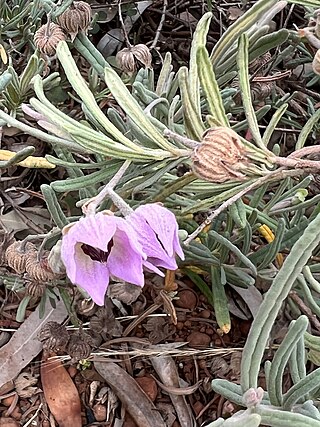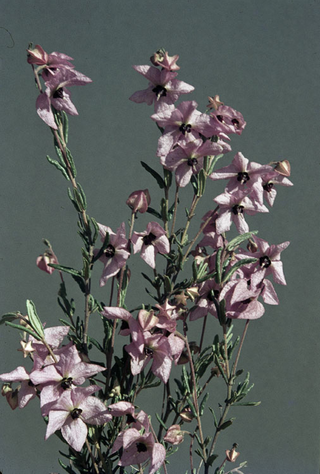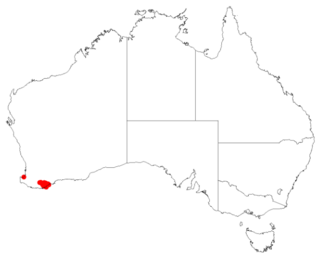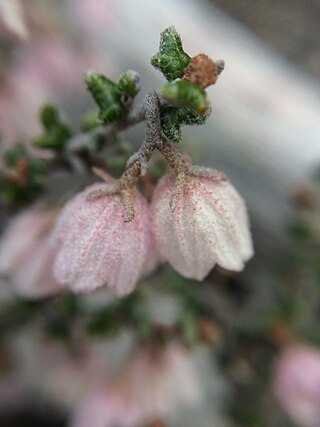
Boronia wilsonii is an erect shrub that is endemic to northern Australia. Its branches, leaves and backs of the flowers are densely covered with woolly hairs. The petals are white to pink or burgundy-coloured.
Philotheca glabra is a species of flowering plant in the family Rutaceae and is endemic to the inland south-west of Western Australia. It is a small shrub with elliptical to club-shaped leaves and white flowers tinged with pink and arranged singly or in twos or three on the ends of branchlets.
Philotheca kalbarriensis is a species of flowering plant in the family Rutaceae and is endemic to Western Australia. It is a shrub with reddish brown branchlets and crowded, narrow spindle-shaped leaves and single white flowers arranged in leaf axils.

Lasiopetalum drummondii is a species of flowering plant in the family Malvaceae and is endemic to the south-west of Western Australia. It is an erect, slender shrub with many densely hairy stems, egg-shaped or oblong leaves and white, pink and red flowers.

Guichenotia intermedia is a flowering plant in the family Malvaceae and is endemic to Western Australia. It is a small shrub with hairy leaves and mauve-pink flowers.
Cryptandra intratropica is a flowering plant in the family Rhamnaceae and is endemic to the Kimberley region of Western Australia. It is a slender, erect or spreading shrub with wedge-shaped to oblong or egg-shaped leaves and clusters of yellow to cream-coloured, tube-shaped flowers arranged in head-like clusters.

Stenanthemum intricatum is a species of flowering plant in the family Rhamnaceae and is endemic to the southwest of Western Australia. It is an erect to spreading, often wiry shrub with sparsely hairy young stems, egg-shaped to fan-shaped leaves and greyish, densely softly-hairy heads of white or cream-coloured flowers.

Guichenotia sarotes is a species of flowering plant in the family Malvaceae and is endemic to the southwest of Western Australia. It is a spindly, low-growing shrub with densely hairy new growth, hairy, greyish, linear leaves and pink to purple flowers arranged in loose groups of two to six.
Stenanthemum petraeum is a species of flowering plant in the family Rhamnaceae and is native to inland Western Australia and the Northern Territory. It is a woody, erect shrub with densely hairy young stems, broadly egg-shaped to more or less round leaves, and clusters of white, densely shaggy- to woolly-hairy flowers.

Leucopogon penicillatus is a species of flowering plant in the heath family Ericaceae and is endemic to the south-west of Western Australia. It is an slender, erect, spreading shrub with egg-shaped to narrowly triangular leaves and white, bell-shaped, bearded flowers arranged in groups of between 3 and 13.

Guichenotia angustifolia is a species of flowering plant in the family Malvaceae and is endemic to the south-west of Western Australia. It is an erect, prostrate or climbing shrub with hairy young growth, hairy, oblong to linear leaves and pink to mauve flowers.
Guichenotia anota is a flowering plant in the family Malvaceae and is endemic to a restricted part of the southwest of Western Australia. It is a low, erect, compact shrub with hairy new growth, oblong to narrowly egg-shaped leaves, and pinkish-purple flowers.

Guichenotia apetala is a flowering plant in the family Malvaceae and is endemic to a small area in the southwest of Western Australia. It is a small, erect, compact shrub with many branches, densely hairy new growth, triangular to heart-shaped leaves, and salmon pink flowers.
Guichenotia asteriskos is a flowering plant in the family Malvaceae and is endemic to the southwest of Western Australia. It is a dwarf, spreading shrub with hairy new growth, linear to narrowly egg-shaped leaves, and white flowers.
Guichenotia astropletha is a flowering plant in the family Malvaceae and is endemic to the southwest of Western Australia. It is a dwarf, spreading shrub with hairy new growth, linear to narrowly egg-shaped leaves, and pink flowers.

Leucopogon stenophyllus is a species of flowering plant in the heath family Ericaceae and is endemic to the south-west of Western Australia. It is an erect, open shrub with a single stem at ground level, linear, narrowly egg-shaped or narrowly elliptic leaves and erect clusters of 3 to 17 white flowers on the ends of branches and short side-branches.
Guichenotia basiviridis is a flowering plant in the family Malvaceae and is endemic to the far west of Western Australia. It is an erect, spreading shrub with hairy new growth, linear leaves with the edges rolled under, and pink flowers arranged in groups of three to seven.
Guichenotia impudica is a species of flowering plant in the family Malvaceae and is endemic to the south-west of Western Australia. It is a spreading, dwarf shrub with hairy new growth, more or less linear leaves with the edges turned down, and pink flowers arranged in groups of six or seven.

Guichenotia micrantha, commonly known as small flowered guichenotia, is a species of flowering plant in the family Malvaceae and is endemic to the south-west of Western Australia. It is a low, compact shrub with linear to narrowly egg-shaped leaves and pink flowers in groups of three to six.

Leucopogon tenuicaulis is a species of flowering plant in the heath family Ericaceae and is endemic to the far southwest of Western Australia. It is an erect or sprawling shrub with thin stems, upright triangular to narrowly egg-shaped or narrowly elliptic leaves and erect, white or pale pink, tube-shaped flower arranged in large groups on the ends of branches and in upper leaf axils.











